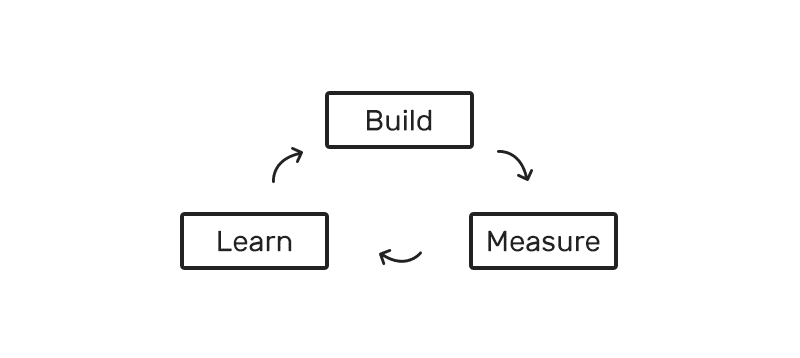What is Lean Startup?
Many of us may have some sporadic ideas what that is about or how to use Lean Startup to build a WordPress business. But, along with these ideas are numerous questions surrounding the concept, such as: Is it a project management methodology? Is it something that complements Agile like Yin and Yang? Do successful startups use this? Is it the book every growth coach advises to read? A way for startups to get rid of the dead weight? A three-fold model that will help you achieve the best with the least?
Well, all these are true in a way, but if you want to put it in a digestible and easily understandable formula for an average WordPress developer, marketer, or someone who is into web design, Lean Startup can be defined as a way of building products that is driven by learning.This learning is acquired by a threefold model of build, measure, learn. This means the process of building a product does not end when a product is built. It actually begins there!
The indicator of your success is not the amount of leads or users you’ve accumulated after your release — it’s how much you have learned from your release and how you use that knowledge to improve your product. This is literally the summary of what Learn Startup is all about.
Eric Ries’s critically acclaimed book, Lean Startup, which serves as the manifesto of this methodology, comprises of three sections: vision, steer and accelerate. Through these sections, you’re walked through the process of building minimum viable versions of your product and putting them into testing, to gain the knowledge that will help you decide if you persevere on the path you’re taking or pivot towards a different direction.
Lean Startup is like the steering wheel you use to drive your car. Kinda!
Fine, but how can I use Lean Startup to build a WordPress business? Lean Startup is designed to help entrepreneurs with their startups and products built in their garage, right!?
Wrong!
Lean Startup can apply for every product that is built for a user or consumer. As long as you build a project for customers/users and you need them to grow, you may apply Lean Startup to build a WordPress business. All of us who live and breathe in the WordPress sphere — designers, developers, business owners, speakers, etc.– are entitled to use it.
Whether you’re designing a WordPress website to be hosted within a WordPress theme, you’re a theme developer, you’re creating a website for a client, you’re working as a web designer for an agency, or you’re building a subscriber list for your WordPress weekly digest or building up a leads list for your upcoming WordPress conference, you all need users to achieve your goals. As Eric Ries also says:
Lean thinking defines value as providing benefit to the customer; anything else is waste
So, let’s get down to business. Where should we begin?
1- Build
Define a Hypothesis
Your product is fueled by an intention, or something that makes you think this product is relevant and has a right to live. That is what is called a hypothesis. Whatever we do in the Lean Startup method will have a goal of proving or disproving this hypothesis.

There are people in X part of the market who needs my X service for X reasons
This is basically a formula to create a hypothesis everyone in any sector can relate to. For Example:
There are premium WP themes users who need extra custom modifications because it’s beyond theme capabilities and my service can help with that.
The very same thing can be defined for other possible businesses such as a WordPress-related publication, an upcoming E-book, a WP related conference and even a simple WordPress website design project. If you’re planning to create a WordPress website for your company or get someone to do it for you, you need to define a hypothesis about its mission, structure and design first.
Define a Minimum Viable Version
If you’re planning to begin a WordPress business, think about the very essential elements of your service, without which, your service will simply not work. Cut down the fancy features. When we say fancy features, we’re not talking about getting rid of a beautiful line icon sitting in your footer.

Rather, there may be parts of your product that look important or non-negotiable to you, but if removed, your product will still serve its basic mission. The scope of your Minimum Viable Product (MVP) is to learn whether your hypothesis is valid or not.
let this simple rule suffice: remove any feature, process, or effort that does not contribute directly to the learning you seek
– Lean Startup
In the example of the WordPress customization service we provided earlier, what you need to validate your hypothesis is a website with one or two services that offer custom code modifications for the premium themes available in ThemeForest. When this is proven to be a right assumption, you can expand your service to more categories like custom design, content management, speed optimisation, and more. Such knowledge can only be acquired by a solid measuring phase to test your product in design, content, functionality and other essential factors.
According to Eric Ries, author of The Lean Startup, consider this state of your product as a ‘baseline product’ towards which your ‘ideal product’ will ultimately be achieved. I’d like to add to that the fact that your product is always in the ‘baseline’ that the ‘ideal’ will never be achieved. You just try so hard to achieve that and that improves your product day by day. But, the ideal will never be achieved.
The day you think your product has achieved the ideal is the end of its story! 🙁
In our case, the baseline version of our exemplary product will include:
- A basic website (maybe just a landing page) to introduce your service and grab projects.
- Software needed to open request tickets.
- Software to place order and handle payments.
- Software to create a briefing section between you and your customers, where the conversation about the flow of project will occur and files will be exchanged.
These seem to be the minimum features we need to create the baseline, or in Lean Startup’s vocabulary, our MVP. Right?
Wrong again!
You can still significantly cut down this feature list by using a ready-made SaaS service to handle most of these requirements. Think about Intercom! It can handle your ticket submission and briefing requirements. Its newly introduced Business Messenger enables your customers to even directly place their orders via Stripe. So most of what you need can already be done by that.
All you need to do is to set up the website and do the basic integration between your website (possibly WordPress) and Intercom, and that’s it! You just saved yourself a lot of time and money. You even made your baseline product ready to be released and put into testing.
What if you’re a WordPress website designer?
Defining an MVP for a product with boundaries hard-drawn by someone else is not easily possible. But, as long as your client or your boss believes in the user-centered development of a website, you can define hypotheses and MVPs for a simple website project as well. You have a vision for a website and the website should fulfil that vision for you. Begin with a baseline version including the pages you believe are vital for your vision. then watch them perform.
The path towards the ideal from baseline can be non-linear and filled with surprises! After starting from baseline, you will put your hypothesis to a test:
- If the reaction to the baseline was positive and aligned with your goal, your hypothesis is proven and you may ‘persevere’ in the path you’re in.
- If the reaction is negative and different than what you were thinking, it’s time to ‘pivot’ towards another direction.
But, what factors should we consider before we decide whether to pivot or persevere? In other words, what should be measured after we release the MVP to make the decision? In the second part of this article, I will show you the ways you can put your baseline into testing and grab important information you need before you can make the decision. We will see the last two important steps in using Lean Startup to build A WordPress business.





No comment yet, add your voice below!